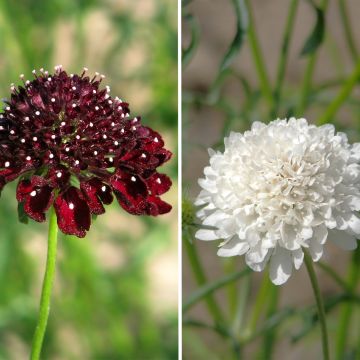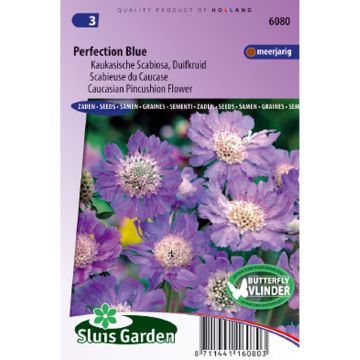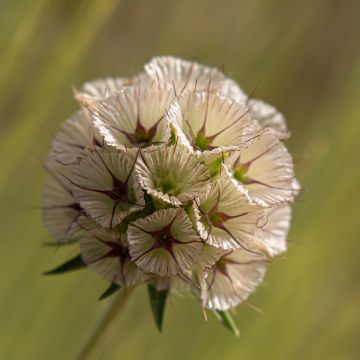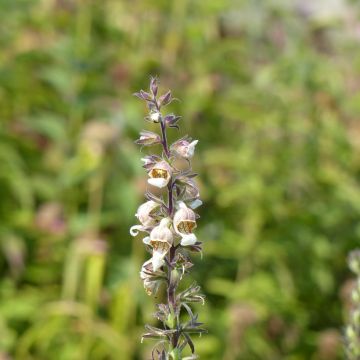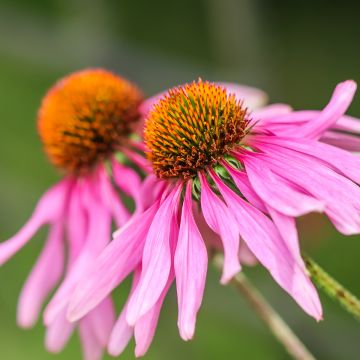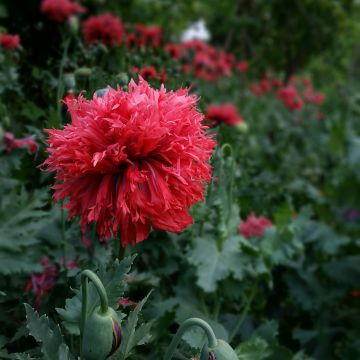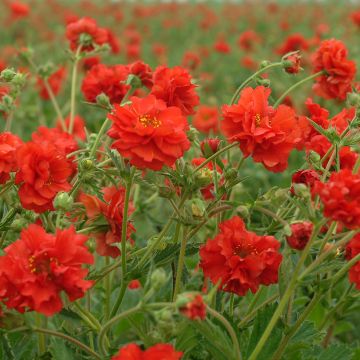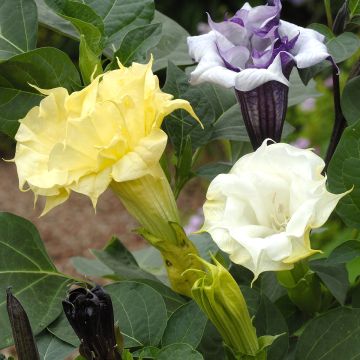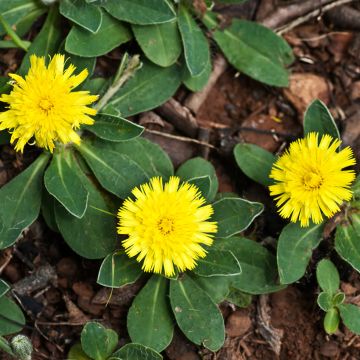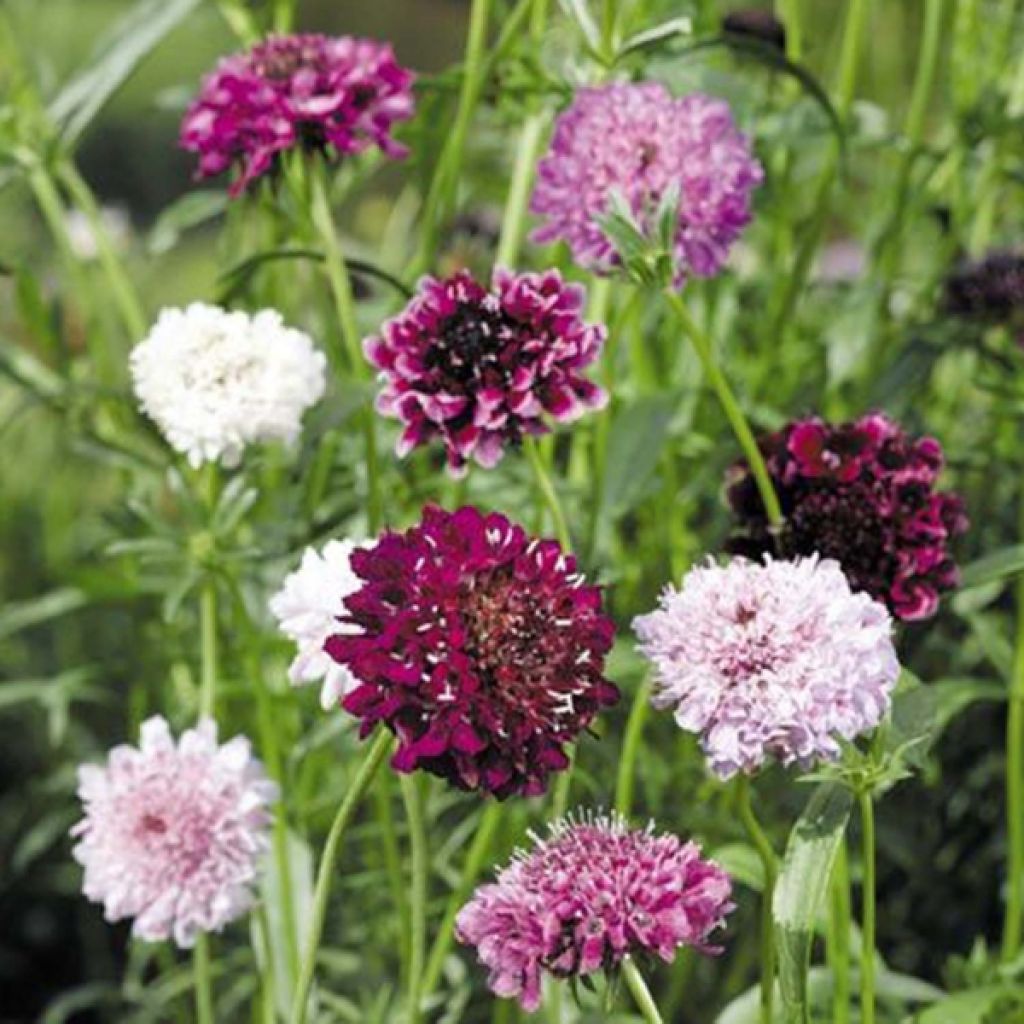

Scabieuse Pin Cushion Mix
Scabiosa atropurpurea Mix
Scabiosa atropurpurea Mix
Sweet Scabious, Mourning Bride
This item cannot be shipped to the selected country
Dispatch by letter from €3.90
More information
Schedule delivery date,
and select date in basket
This plant carries a 6 months recovery warranty
More information
We guarantee the quality of our plants for a full growing cycle, and will replace at our expense any plant that fails to recover under normal climatic and planting conditions.
Seed-only orders are dispatched by sealed envelope. The delivery charge for seed-only orders is €3.90.
Does this plant fit my garden?
Set up your Plantfit profile →
Description
Scabious atropurpurea is offered here as a mix of seeds that will produce flowers in soft and vibrant colours including white, pale pink to fuchsia, mauve, garnet, purple, etc. The plants are not very long-lived, but they grow very quickly and their flowering lasts for several months if you regularly remove faded flowers. Scabious atropurpurea thrives in sunny positions, in well-draining soil that doesn't dry out too much. Sow the seeds from March to May, depending on the climate, along borders or in flower beds.
Scabiosa atropurpurea, also known as Dark Purple Scabious, is a plant from the Dipsacaceae family. This species is native to southern Europe. It develops from a deep and extensive root system. It is often grown as an annual, although it is actually a short-lived perennial. This diverse selection showcases several varieties offering a wide choice of colours. The plants quickly form erect bushy clumps 50-60cm (20-24in) in heightand about 30cm (12in) wide. The deciduous foliage is composed of finely cut, roughly toothed, lanceolate leaves with a grey-blue hue. It emerges from the collar of the plant, forming a flat rosette close to the ground. Flowering occurs from July to October. Each plant produces up to 400 flowers and numerous stems, each carrying a single dome-shaped floral head, 5cm (2in) in diameter, composed of a multitude of tiny flowers. The stamens resemble miniature pin cushions. The fragrant flowering is also highly attractive to bees and butterflies.
Once the queen of old-fashioned gardens, Scabious has made a comeback, with a variety of classic and innovative colours. The flowers of Scabiosa atropurpurea are graceful and elegant, far from being austere as their English name "Mournful Widow" suggests. They are an excellent choice for flower beds, as well as for making bouquets. Combine these plants with carnations, love-in-a-mist, cosmos, cornflowers, etc.
Report an error about the product description
Flowering
Foliage
Plant habit
Botanical data
Scabiosa
atropurpurea
Mix
Dipsacaceae
Sweet Scabious, Mourning Bride
Cultivar or hybrid
Other Scabiosa seeds
Planting and care
Sow the seeds of Scabiosa atropurpurea in April-May, directly in the ground, in their final location. Prepare the soil carefully by loosening it and, if necessary, lightening the planting area with coarse sand. Sow at a depth of 3 mm (0in), in rows spaced 30cm (12in) apart. Another option is to sow the seeds in 7.5cm (3in) pots, which should be kept at 18-20°C (64.4-68°F) until germination. Keep the soil moist, but not excessively wet. Transplant the seedlings when they are large enough to handle, planting them outside during periods when there is no risk of frost, with a spacing of 23cm (9in) between each plant. Scabiosa thrives in sunny locations, in well-drained soil that allows it to withstand winter conditions. It adapts to slightly acidic, neutral, or slightly alkaline soils. Regular, but not excessive, watering will promote its growth. Regularly removing faded flowers will encourage a long flowering period. This plant readily self-seeds in light soil, although not always reliably.
Sowing period
Intended location
-
, onOrder confirmed
Reply from on Promesse de fleurs
Flower seeds
Haven't found what you were looking for?
Hardiness is the lowest winter temperature a plant can endure without suffering serious damage or even dying. However, hardiness is affected by location (a sheltered area, such as a patio), protection (winter cover) and soil type (hardiness is improved by well-drained soil).

Photo Sharing Terms & Conditions
In order to encourage gardeners to interact and share their experiences, Promesse de fleurs offers various media enabling content to be uploaded onto its Site - in particular via the ‘Photo sharing’ module.
The User agrees to refrain from:
- Posting any content that is illegal, prejudicial, insulting, racist, inciteful to hatred, revisionist, contrary to public decency, that infringes on privacy or on the privacy rights of third parties, in particular the publicity rights of persons and goods, intellectual property rights, or the right to privacy.
- Submitting content on behalf of a third party;
- Impersonate the identity of a third party and/or publish any personal information about a third party;
In general, the User undertakes to refrain from any unethical behaviour.
All Content (in particular text, comments, files, images, photos, videos, creative works, etc.), which may be subject to property or intellectual property rights, image or other private rights, shall remain the property of the User, subject to the limited rights granted by the terms of the licence granted by Promesse de fleurs as stated below. Users are at liberty to publish or not to publish such Content on the Site, notably via the ‘Photo Sharing’ facility, and accept that this Content shall be made public and freely accessible, notably on the Internet.
Users further acknowledge, undertake to have ,and guarantee that they hold all necessary rights and permissions to publish such material on the Site, in particular with regard to the legislation in force pertaining to any privacy, property, intellectual property, image, or contractual rights, or rights of any other nature. By publishing such Content on the Site, Users acknowledge accepting full liability as publishers of the Content within the meaning of the law, and grant Promesse de fleurs, free of charge, an inclusive, worldwide licence for the said Content for the entire duration of its publication, including all reproduction, representation, up/downloading, displaying, performing, transmission, and storage rights.
Users also grant permission for their name to be linked to the Content and accept that this link may not always be made available.
By engaging in posting material, Users consent to their Content becoming automatically accessible on the Internet, in particular on other sites and/or blogs and/or web pages of the Promesse de fleurs site, including in particular social pages and the Promesse de fleurs catalogue.
Users may secure the removal of entrusted content free of charge by issuing a simple request via our contact form.
The flowering period indicated on our website applies to countries and regions located in USDA zone 8 (France, the United Kingdom, Ireland, the Netherlands, etc.)
It will vary according to where you live:
- In zones 9 to 10 (Italy, Spain, Greece, etc.), flowering will occur about 2 to 4 weeks earlier.
- In zones 6 to 7 (Germany, Poland, Slovenia, and lower mountainous regions), flowering will be delayed by 2 to 3 weeks.
- In zone 5 (Central Europe, Scandinavia), blooming will be delayed by 3 to 5 weeks.
In temperate climates, pruning of spring-flowering shrubs (forsythia, spireas, etc.) should be done just after flowering.
Pruning of summer-flowering shrubs (Indian Lilac, Perovskia, etc.) can be done in winter or spring.
In cold regions as well as with frost-sensitive plants, avoid pruning too early when severe frosts may still occur.
The planting period indicated on our website applies to countries and regions located in USDA zone 8 (France, United Kingdom, Ireland, Netherlands).
It will vary according to where you live:
- In Mediterranean zones (Marseille, Madrid, Milan, etc.), autumn and winter are the best planting periods.
- In continental zones (Strasbourg, Munich, Vienna, etc.), delay planting by 2 to 3 weeks in spring and bring it forward by 2 to 4 weeks in autumn.
- In mountainous regions (the Alps, Pyrenees, Carpathians, etc.), it is best to plant in late spring (May-June) or late summer (August-September).
The harvesting period indicated on our website applies to countries and regions in USDA zone 8 (France, England, Ireland, the Netherlands).
In colder areas (Scandinavia, Poland, Austria...) fruit and vegetable harvests are likely to be delayed by 3-4 weeks.
In warmer areas (Italy, Spain, Greece, etc.), harvesting will probably take place earlier, depending on weather conditions.
The sowing periods indicated on our website apply to countries and regions within USDA Zone 8 (France, UK, Ireland, Netherlands).
In colder areas (Scandinavia, Poland, Austria...), delay any outdoor sowing by 3-4 weeks, or sow under glass.
In warmer climes (Italy, Spain, Greece, etc.), bring outdoor sowing forward by a few weeks.

































